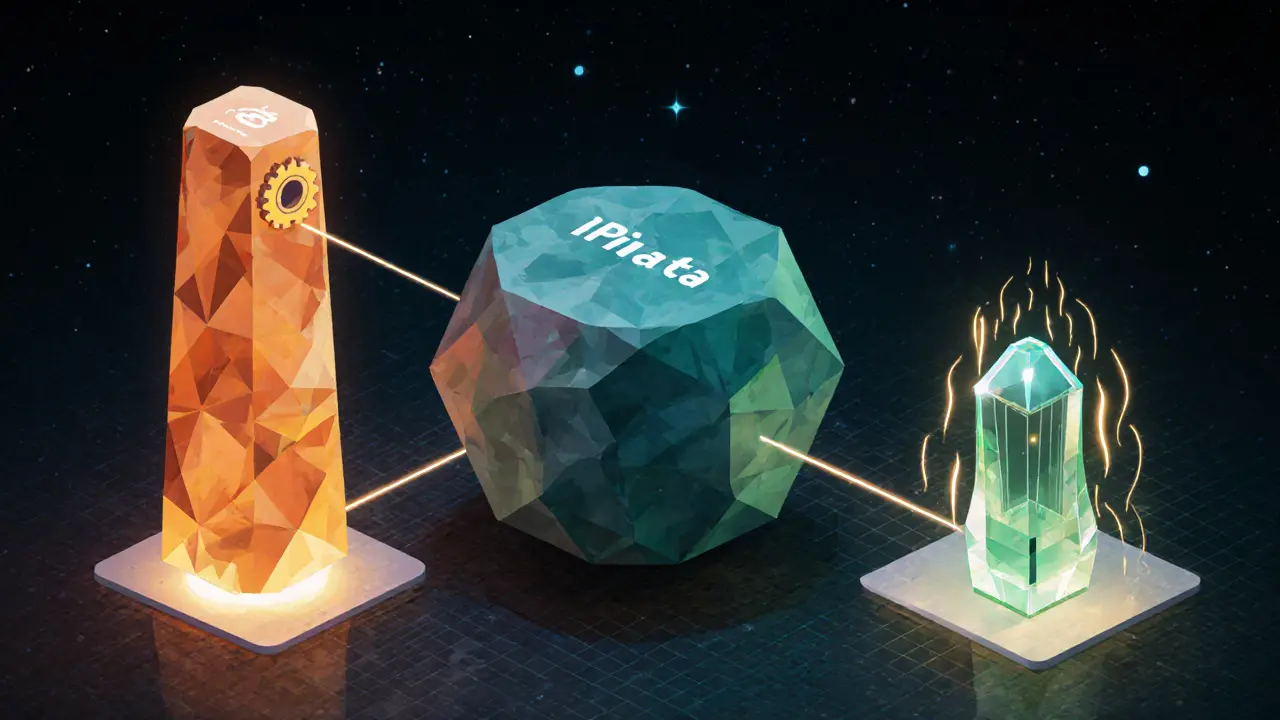How to Use IPFS for Secure NFT Metadata Storage

IPFS CID Generator & Validator
Enter metadata or CID above to see results
- Immutability: Once pinned, the CID never changes.
- Decentralization: Content lives on many nodes, reducing outage risk.
- Cost Efficiency: Free tiers from services like NFT.Storage cover small projects.
- Transparency: Anyone can verify the hash matches the original file.
- Permanence: Data persists even if original servers go offline.
If you’ve ever worried that an NFT’s artwork might vanish because the link points to a centralized server, you’re not alone. The cure is IPFS NFT metadata - a decentralized way to lock the data that defines your token forever. Below you’ll learn why IPFS is the go‑to choice, how to get it working, and what to watch out for.
How IPFS Works for NFT Metadata
When you first hear about IPFS is a peer‑to‑peer file system that stores data by its cryptographic hash instead of a location. In practice, you upload a JSON file that follows the ERC‑721 or ERC‑1155 standard, and IPFS returns a unique Content Identifier (CID) - a string of letters and numbers generated with SHA‑256. The CID is immutable: anyone who fetches that CID will always receive the exact same file.
The NFT contract on the blockchain then references the CID via an ipfs:// URI. When a marketplace or wallet reads the token’s metadata, it pulls the JSON from the IPFS network, reads the link to the image or video, and displays it to the user. Because the address is content‑derived, the data cannot be redirected or swapped after minting.
Why Choose IPFS Over Centralized Solutions
Centralized storage (AWS S3, Google Cloud) gives you fast uploads and easy dashboards, but the URLs are mutable. If the server goes down or the owner changes the file, the NFT’s visual component disappears or, worse, shows something else. With IPFS, the CID guarantees immutability, and the distributed network provides resilience against single‑point failures.
Key advantages:
- Immutability: Once pinned, the CID never changes.
- Decentralization: Content lives on many nodes, reducing outage risk.
- Cost efficiency: Free tiers from services like NFT.Storage cover small projects; Pinata’s paid plans scale with usage.
- Transparency: Anyone can verify the hash matches the original file.
That said, IPFS can be slower to upload large collections and requires a pinning strategy to keep data alive. The trade‑off is worth it for high‑value art, collectibles, and gaming assets where permanence is non‑negotiable.
Setting Up IPFS for Your NFT Project
There are three typical paths, each with a different skill curve:
- Run Your Own Node: Install the IPFS client, add files, and manage pinning yourself. Expect 2‑4 weeks of learning if you’re new to the protocol.
- Use a Managed Pinning Service: Sign up for Pinata, a platform that offers an API, dashboard, and automated pinning. Integration can be done in 1‑2 days.
- Zero‑Code Services: Platforms like NFT‑Inator or the free tier of NFT.Storage let you upload JSON and assets via a web UI or a one‑line JavaScript call. You can be live in a few hours.
Typical workflow:
- Create a JSON file that follows the ERC‑721 metadata schema (name, description, image, attributes).
- Upload the image file to IPFS; record its CID.
- Insert the image CID into the JSON, then upload the JSON itself to IPFS.
- Store the final JSON CID in your smart contract’s
tokenURIfield using theipfs://prefix.
Make sure to pin both the image and the metadata JSON, otherwise the network may garbage‑collect unpinned content after a few days.

Pinning Services: Pinata vs NFT.Storage
| Feature | Pinata | NFT.Storage |
|---|---|---|
| Free tier | 5 GB storage, 10 GB bandwidth | Uncapped storage for verified projects, limited bandwidth per month |
| Pricing (beyond free) | $0.15/GB per month (enterprise plans available) | Pay‑as‑you‑go $0.10/GB for extra bandwidth |
| API maturity | Full REST API with bulk pinning, OAuth support | Simple HTTP API, designed for quick integration |
| Dashboard UX | Advanced analytics, pin status, file explorer | Minimalist UI, focus on one‑click uploads |
| Community support | Active Discord, extensive docs, tutorials | GitHub Issues, open‑source SDKs |
For most creators, NFT.Storage wins on ease of use and cost for small collections, while Pinata shines when you need granular control, bulk management, or enterprise‑grade SLAs.
Best Practices & Common Pitfalls
Here are the rules that separate a robust NFT launch from a “broken link” disaster:
- Pin Everything: Pin both media (image, video) and the metadata JSON. Unpinned files can disappear after a week.
- Validate CIDs: Before writing the CID to the contract, fetch it through a public gateway (e.g., https://ipfs.io/ipfs/
) to confirm the content matches what you expect. - Use a Reliable Gateway: Relying on a single gateway can cause latency spikes. Offer multiple gateways (IPFS.io, Cloudflare) in your UI.
- Avoid Large Files: Split large videos into shorter clips or use reference pointers to keep upload times reasonable.
- Version Control: Never overwrite an existing CID. If you need to update, mint a new token or use a mutable pointer like IPNS (with caution).
- Public vs Private: Remember that everything on IPFS is public. If you need privacy, encrypt the file before uploading and store the decryption key off‑chain.
Developers often forget the difference between a CID and a gateway URL. The CID is the immutable identifier; the gateway URL (https://gateway.ipfs.io/ipfs/
Future Trends and Emerging Standards
IPFS is moving fast. Recent protocol upgrades improve content discovery and reduce latency, making it feel more like a CDN. Analysts predict that by 2027, over 70% of high‑value NFT projects will reference IPFS CIDs directly in their contracts.
Two developments worth watching:
- EIP‑4804: An Ethereum standard that encourages on‑chain references to IPFS content, potentially enabling cheaper “lazy minting” where the metadata is written only when the token is first transferred.
- Layer‑2 Pinning Solutions: Projects are experimenting with rollup‑based pinning that batches pin requests, cutting costs for massive collections.
As regulatory bodies start judging NFT authenticity, immutable storage like IPFS could become a compliance requirement, giving creators an extra layer of legal protection.
Frequently Asked Questions
What is the difference between an IPFS CID and a gateway URL?
The CID is the hash that uniquely identifies the file on the IPFS network. A gateway URL simply wraps that CID in an HTTP address so browsers can retrieve the file without running an IPFS node.
Do I need to run my own IPFS node to store NFT metadata?
No. You can use managed pinning services like Pinata or NFT.Storage, which handle node operations for you. Running your own node gives more control but adds complexity.
How can I ensure my NFT metadata stays available forever?
Pin the content on at least two independent services and periodically check the CID through public gateways. Some creators also back up the files on traditional cloud storage as an extra safety net.
Is IPFS compatible with all blockchains?
Yes. Because IPFS operates off‑chain, any blockchain that can store a string (the CID) can reference IPFS content. Popular chains like Ethereum, Polygon, Solana, and Hedera all use IPFS for NFT metadata.
Can I store private data on IPFS?
IPFS is public by design. To keep data private, encrypt it before uploading and store the decryption key off‑chain or in a secure vault.

Promise Usoh
October 4, 2025 AT 08:35When one contemplates the metaphysical implications of storing artistic provenance on a distributed hash table, the notion of permanence emerges as a philosophical cornerstone. The immutable CID of IPFS is not merely a technical artifact; it is a testament to the desire for an unalterable narrative, a resistance against the ephemerality of centralized servers. In an era where digital artefacts can be censored with a single command, the hash‑based address provides a kind of digital integrity that echoes the ancient concept of a fixed point in the cosmos. Moreover, the decentralised nature of the network distributes trust across a multitude of nodes, thereby diffusing power away from singular authorities, much like the diffusion of knowledge in a republic. One must also consider the cost model: free tiers from services such as NFT.Storage democratise access, allowing creators from under‑represented regions to embed their work in a resilient substrate. Yet the responsibility does not end at pinning; periodic verification through public gateways ensures that the stored hash continues to resolve to the intended asset, guarding against inadvertent drift. The interplay between pinning services like Pinata, which offer granular control, and zero‑code platforms, which accelerate deployment, reflects a broader dialectic between control and convenience. From a developer’s perspective, the workflow-upload image, embed its CID into JSON, then pin the JSON-constitutes a deterministic pipeline that minimizes human error. The CID, being derived from cryptographic hashing, guarantees that any alteration would produce a completely different identifier, thus preventing subtle tampering. In the wider context of regulatory scrutiny, immutable storage may become a compliance prerequisite, underscoring the legal as well as aesthetic imperatives. As the ecosystem evolves, upcoming standards such as EIP‑4804 promise to further entrench IPFS hashes within on‑chain logic, enabling lazy minting and reducing gas costs. Lastly, it is worth noting that while the network confers resilience, it does not absolve creators from ethical considerations; public visibility of all pinned content means that privacy must be engineered through encryption if required. In sum, the marriage of IPFS with NFT metadata is not just a technical convenience-it is a philosophical commitment to permanence, decentralisation, and equitable access.
Tyrone Tubero
October 18, 2025 AT 18:35Yo, this whole IPFS thing is like the haute couture of NFT storage-so fancy but you gotta wear it right or you look like a clown. The CIDs are the new black, bro, and if you don’t pin ’em, they just vanish like my hopes after a bad date. Seriously, go pin that shit on Pinata or NFT.Storage, don’t be lazy.
Bhagwat Sen
November 2, 2025 AT 03:35Alright folks, let me break it down: you upload your art, you get a CID, you drop that CID in your tokenURI and boom – your NFT lives forever on the network. No fuss, no gatekeepers, just pure peer‑to‑peer magic. Make sure you pin both the image and the JSON, otherwise the network will garbage‑collect them like yesterday’s memes. Also, test the CID on multiple gateways so you know it’s solid everywhere.
mukesh chy
November 16, 2025 AT 13:35Oh great, another “just pin it and forget it” tutorial. As if the IPFS elves will magically keep your data alive forever without any maintenance. Newsflash: the network is not a babysitter; you still need redundancy, monitoring, and a solid backup plan. Otherwise you’ll end up with a fancy broken link that no one cares about.
Eva Lee
November 30, 2025 AT 23:35From a systems‑architecture standpoint, leveraging a managed pinning service abstracts away the low‑level node orchestration, allowing developers to focus on token economics and UI/UX. Pinata’s RESTful API facilitates bulk operations, while NFT.Storage provides a streamlined SDK for quick integrations. It’s crucial to implement retry logic on uploads to handle transient network failures, and to hash‑verify the content post‑pin to ensure integrity. Additionally, consider multi‑region pinning to mitigate latency spikes across geographies.
Adarsh Menon
December 15, 2025 AT 09:35Seriously, you think just dropping a CID is enough? You gotta think about the whole ecosystem-gateway latency, pinning redundancy, and the fact that some users still rely on centralized proxies. If your NFT metadata disappears, your whole project looks like a bad joke. So do the work, pin everywhere, and test often.